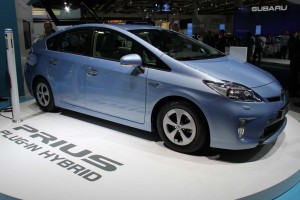Toyota delivered an unexpected surprise when it formally announced the launch of its new Prius Plug-in model, revealing it will be priced starting at $32,760, well above what the maker had initially signaled.
That’s a more than $9,000 premium for the lithium-ion-powered version of the Prius, which will be able to deliver up to about 15 miles in electric-only mode. A fully loaded version of the Prius Plug-in, meanwhile, will go for $40,285.
The new model will still be about $7,000 cheaper than the Chevrolet Volt – which is seeing its price cut by $1,005 to $39,995 for 2012, including delivery charges. But that figure can be misleading. The Volt will qualify for a full $7,500 tax credit under the federal government’s incentive program, while the new Prius Plug-in will receive only a third of that amount.
So the out-of-pocket difference between the Prius Plug-in and Volt will actually work out to only about $2,200.
The smaller, $2,500 incentive on the Prius Plug-in reflects the fact that the government program is based on the size of a vehicle’s battery pack. Toyota’s new plug-in hybrid uses a significantly smaller pack than the 16 kilowatt-hours of lithium-ion batteries in the Volt.
That means that Prius, at 15 miles per charge, will also get significantly less range than the Volt, which is rated to deliver about 35 miles per charge, on average. GM officials have claimed that the Chevrolet model, which they prefer to call an extended-range electric vehicle, can handle the daily needs of about 70% of American commuters without needing to fire up its internal combustion engine.
(Toyota reveals the new Prius Plug-in hybrid during the Frankfurt Motor Show. Click Here for more.)
Government data suggest that the Toyota Prius Plug-in will handle only about a third of commuters’ driving without using gasoline for at least some of their daily needs.
However, the Toyota model will do better than its domestic rival once it switches on the internal combustion engine, with the Plug-in rates at 44 mpg in the City, 40 on the Highway, according to the EPA.
But if fuel economy were the only factor buyers likely wouldn’t be buying a plug-in. The new model – like Volt – is aimed at motorists who want to stop using gasoline all together, so many analysts are wondering whether the Prius Plug-in really will charge up the public.
Those 15 miles on battery power, if driven even seven days a week would result in barely 2 gallons in gas saved – equal to barely $8 in weekly fuel savings, or about $400 a year. Even after working in the $2,500 federal tax credit, it would take over 20 years to make up the added cost for the Plug-in versus a regular Prius hybrid.
Meanwhile, the Prius Plug-in will have a speed limited to 62 mph on battery compared to 100 mph for Volt — though both models will achieve their best battery range at lower speeds.
So, whether buyers will be drawn to the cheaper Prius Plug-in or the higher-range Chevrolet Volt remains to be seen.
The first Toyota Prius Plug-in will reach showrooms in October, the maker initially targeting select markets in California, Oregon, Washington, Arizona, Maine, Massachusetts, Vermont, New Hampshire, Rhode Island, Connecticut, New York, New Jersey, Maryland and Virginia. Dealers in the rest of the country will start getting the plug-ins sometime in 2013.
Meanwhile, Toyota has also announced pricing for another model it is adding to the new Prius “family” of hybrids. The larger Prius V wagon will start at $27,925, including shipping, with a fully-loaded Prius V Five going for $30,750.
Toyota plans to add yet another model to the Prius line-up, a compact hybrid it has dubbed the Prius C. It is due for introduction next year.
The decision to price the PriusPlug-in at well over $30,000 comes as a surprise to many observers. Senior company officials had earlier hinted they would aim for a “significant” price advantage over the Volt, not a figure less than $3,000 after federal tax incentives. The final number appears to suggest that the Asian maker had to account for lopsided exchange rates that are penalizing any product now imported from Japan.


A fully battery powered vehicle can easily get 70miles per charge, they did it in the 60’s and then again in the early 00’s.
Why can’t they just bring back the EV1 and EV2 that GM made?